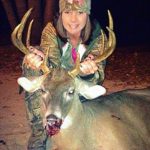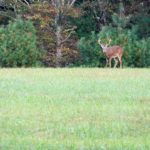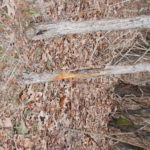
Don’t put trophy bucks on the back burner.
Deer hunters are funny. Many of them sit in their stands for months, peering through the woods hoping to see a trophy deer.
“I can’t wait for the leaves to drop, then I can see all that area out there and over that way and back up there,” many think.
Unfortunately, when Thanksgiving rolls around and the leaves have dropped and a hunter has a good view of everything around him, he can see everything except a deer.
Danny Buxton is an independent wildlife consultant from Smoaks who manages several properties in South Carolina’s coastal region. He said hunters who yearn to have another shot at the October rut just need to be patient for a few weeks. While a few hunters may stick it out, many stop targeting trophy bucks after Thanksgiving and start meat-hunting for does. Buxton is a firm believer in the secondary rut; he said you can mark it on your calendar.
“There is always a secondary rut,” said Buxton, who tries his best to hunt every day of the 4 ½-month season in Game Zone 3. “I call it the ‘new rut.’ It’s made up of unbred does after they were in their estrus period but didn’t get bred. When a doe comes into heat, if she doesn’t take the first time, 28 days later, she’ll come back in again.”
Before you get too excited that good times are about to be here again, Buxton warns that the secondary rut is similar to the primary rut in a lot of ways but also very different. It all boils down to hormones and hunting pressure.
“Hunting the rut is hunting the rut, no matter when it happens,” he said. “You still want to pay attention to the signs. If you find a scrape that’s being refreshed, if you find a doe that is in heat, you need to shadow her. The second thing is when you come into the late-season secondary rut, you have to go in quietly. I always say ‘Quiet please.’”
Deer that have been hunted hard for several months know what is going on. While hunters were patterning deer, deer were also patterning hunters. Typically, a trophy buck is much better at that game than the hunter.
“In Colleton County, my season comes in Aug. 15 to Jan. 1, so you’ve got how many months of just hunting pressure? If you’ve been driving that ATV in, a half-mile from your deer stand, maybe you want to just take that extra walk, because come the late season, he’s been patterned to know that noise,” Buxton said.
Going nocturnal is a natural choice for mature bucks to do their business while waiting out the commotion and impending doom that comes with showing himself during the day.
“Late-season deer are very nocturnal creatures because of the pressures. They’re going to spend a lot of their daylight hours in thick security cover,” he said. “If you’re 100 yards out and you know he’s bedding in this 20-acre patch and he’s bedding down in there, he’s not getting up until it’s black dark. That’s why late-season hunting can be tough, but there are a couple things you can do.”
Most veteran hunters known that patterning bucks during the rut, even bucks that aren’t kings in their section of the woods, is basically patterning does. Patterning does means knowing food sources. Whether a doe has already been bred or missed the first go-round, her instincts tell her she needs to eat. Winter is coming, and nutrition and fat reserves are all-important to survive the winter when food becomes scarce.
Buxton said it’s not just does that feel the strain of the concurrent mating and hunting seasons. Bucks are worn down as well and have to eat — sometimes at the risk of their own security.
“A buck’s going to get so worn down from chasing does and avoiding hunters,” he said. “Then, when the mercury drops, he goes into survivor mode. By the late season, he’s going to need to regenerate fat reserves by refueling with large amounts of food, even at the expense of security by feeding in daylight hours.”
When scouting, Buxton suggests confirming that fresh rutting sign is present: bucks refreshing scrapes or even signs of scuffling with subordinate deer. He stresses the importance of finding food sources that does and bucks are eating, preferably close to bedding cover. That’s the main reason Buxton spends so much of his time in the offseason planting and fertilizing a variety of food plots.
“Wheat and oats provide energy for deer, so that’s what everybody wants to plant as their winter crops in their food plots because it provides that energy for the rut and after the rut, and it builds them back up,” he said.
“I also plant a lot of clover. Clover is a great energy source that will come in from December through March. Clover helps get the deer built back up so when it comes antler-growing time, he’s growing antler and not still trying to recover from the past season.”
Veteran hunter Scott Emery of Greer has a tried-and-true tactic for killing late-season trophies. His strategy takes all of the situations outlined and described by Buxton into one hunting game plan; he finds a southern-facing clear-cut.
“Once the nighttime temperatures consistently stay below freezing, you won’t find me hunting deep in the woods where it stays dark most of the morning,” Emery said. “For one thing, it’s cold, and I figure if I’m cold, the deer are cold, so they’re going to go somewhere they can get warm. But they’re not stupid; they’re not going to stand out in the open. So if we’re talking about a place that deer can warm in the sun and still stay hidden — we’re talking about a clear-cut.”
Emery suggests that hunters prepare to be mobile when hunting clear-cuts. He prefers a climbing stand or portable ladder stand to erect on the downwind edge of a clear-cut, and he doesn’t mind climbing as high as he needs to in order to have good visibility. He’s not as much a slave to the wind if he’s 50 feet off the ground shooting at bucks 200 yards distant.
“Naturally, a clear-cut that has some elevation to it works out better than one that’s completely flat,” Emery said. “A hillside provides a good wind break, plus, the southern side is usually facing the sun in the morning, so it will warm faster. It’s also easier to see deer on a hillside clear-cut than one on a long, flat area. That doesn’t mean you can’t hunt a flat area; it just means you can’t cover as much ground, so you’re hunting closer, and if you’re within 100 to 150 yards, you’ll have to pay more attention to the wind.
“If a good deer gets by me without presenting a good shot or I see a bunch of does using the other end of the clear-cut I’m on, I’ll relocate my stand during midday or after dark and be ready for them on the next hunt,” he said. “A clear-cut is not just a random parking lot; there are certain trails and paths that deer take going in and out and to move through the area itself.”
While setting up anywhere along the edges of a clear-cut may sound easy, there are a number of considerations to be made. Deer use clear-cuts as both feeding and bedding areas. There’s also the position of the sun and being able to locate a deer after the shot has been made.
“I like to position myself where the deer can take advantage of the sun, but you have to be careful that you don’t end up looking right into the sun when it comes time to shoot. If you’ve ever picked up a scope and tried to look through it in the direction of the sun, it’s like somebody’s shining a bright light in your face. You also want to be as quiet as possible getting into the stand before the hunt, because there may be deer bedded right under you.”
Emery suggests that the last few weeks of the season might be a good time to skip getting into the stand before daylight and having to use a flashlight to find your way to your tree stand. He offers that he rarely sees deer in the first hour of daylight, as they seem to prefer to linger in the bedding areas until the sun rises a little and warms things up — and that’s fine by him.







Be the first to comment